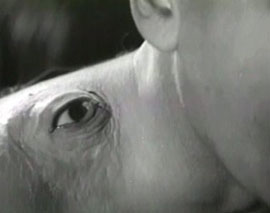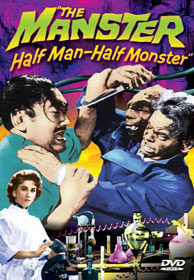 A guy in a gorilla suit appears as a silhouette on rice paper doors, doors soon to be splashed with blood as a Japanese maiden screams.
A guy in a gorilla suit appears as a silhouette on rice paper doors, doors soon to be splashed with blood as a Japanese maiden screams.
So begins The Manster (Kyofu, 1962). As the film progresses, the authentic Japanese sets & locations will make it seem to have a bigger budget than is the case. Nearly competent acting also helps while the story stumbles through a ludicrous script with some of the silliest-ever horror elements.
As a combined American & Japanese production, it really turns out being the worst of two worlds rather than the best of either, but the hybridization of cinematic techniques going all awry is worth observing.
The ape Kenji had once been a human being. He now dwells in a cavernous laboratory inside a volcanic mountain, together with prehistoric plants. And Dr. Suzuki, responsible for Kenji's condition, must now kill him. For spice we also get glimpses of Emiko (Toyoko Takechi), a monstrously altered woman living in a cage in the same secret lab. She'd once been Dr. Suzuki's wife & assistant.
 Unsuspecting American reporter Larry (Peter Dyneley) visits the mountain lab. When he returns to Tokyo, the scientist follows him to see how he's effected by the enzyme secretly slipped to him. Unsuspecting American reporter Larry (Peter Dyneley) visits the mountain lab. When he returns to Tokyo, the scientist follows him to see how he's effected by the enzyme secretly slipped to him.
Dr. Suzuki is played by Tetsu Nakamura (aka, Satoshi Nakamura), one of the few Japanese actors who could speak their own dialogue in bad Japanese science fiction films, & so a natural for an American film made in Japan.
Dr. Suzuki becomes Larry's regular drinking buddy exploring Tokyo nights. The foolish foreign barbarian thinks they're friends, but it's only Suzuki's method of keeping tabs on his experiment, as Larry slowly turns into a new species, Homo sonofabitchii.
The reporter's first transformation is psycological. He turns from a a man who loves his wife Linda (played by Dyneley's real-life wife Jane Hylton; both were would-be actors of the near-failure sort) into a playboy who prefers his Japanese hotty Tara (Terri Zimmern).
 As the transformation becomes physiological, it starts out with an eyeball growing on his shoulder. As the transformation becomes physiological, it starts out with an eyeball growing on his shoulder.
Soon the eyeball has grown into a fanged head, that's right, a second head. These moments of metamorphoses are actually kind of spiffy as trash horror goes; it won't get any better when we reach the climax.
And rather famously, this goofy sequence inspired the bilateral division of Ash & Evil Ash in the third Evil Dead movie, so Manster gets credited for inducing Sam Raimi & Bruce Campbell to give us possibly the single funniest extended bit in all horror cinema. It seems likely also to have been the inspiration for the hysterical How to Get Ahead on Advertising (1989).
The two-headed Manster's make-up design is wonderfully laughable, helping to make this a superb example of "great bad" cinema. It's too bad there wasn't a better supporting event than the protracted night-chase to bolster the badness, but we can't ask too much of a film this thrillingly awful.
Dr. Robert Suzuki regrets his experiment, but he cannot reverse the process. He hopes that volcanic heat will be the added ingredient to effect a complete separation of two-headed Larry into two beings, so must bait him back to the laboratory in the mountain. When the complete devision of one creature into two is complete, will either one of them be human? Ah! The mystery!
 It is perhaps not too surprising that such a ridiculous idea for horror movies as "two headed man" would make a much, much better film if just treated as pure comedy. And How to Get Ahead in Advertising is just a delightfully cynical black comedy that mixes cynicism with veritable slapstick.
It is perhaps not too surprising that such a ridiculous idea for horror movies as "two headed man" would make a much, much better film if just treated as pure comedy. And How to Get Ahead in Advertising is just a delightfully cynical black comedy that mixes cynicism with veritable slapstick.
A stressed out advertising slogan writer can't come up with a slogan for a new pimple cream, perhaps because he's beginning to have doubts about having spent his life up to now selling garbage to rubes.
His doubts & problems surrounding his job begin to affect his homelife. & he's not all that capable of managing any part of his life. So he breaks out with an enormous zit on his shoulder.
The zit grows a hideous little face. Our ad-man tries to hide his affliction, but in fact his filthy minded talking zit is only acting out in ways Dennis can't.
And Richard E. Grant in the role of Dennis is delivering a performance of a lifetime. He has wonderful manic conversations with his zit as to the meaning of life, the wallaby, & advertising, which of course gets people to thinking Dennis has lsot his mind talking to himself.
 When Dennis is at the end of his wits & ready to get rid of the inflamed boil surgically, the demon-zit proves mightier. When Dennis is at the end of his wits & ready to get rid of the inflamed boil surgically, the demon-zit proves mightier.
His zit or boil grows swiftly into a duplicate head while Dennis's original head shrinks down to a talking boil on the opposit shoulder. No one detects the change, despite that the new head has a mustache.
The new anti-Dennis takes over with a meaner, less principled, & much more effective take on the value of dishonesty, the primary requirement for successful advertising.
A lampoon on consumerism, commercialism, & the advertising world, it's an intelligent film even apart from teh wonderfully absurd fantasy element. Dark as it gets, without hope or happy ending, it is even so first & foremost laugh-out-loud funny.
copyright © by Paghat the Ratgirl
|


 Unsuspecting American reporter Larry (Peter Dyneley) visits the mountain lab. When he returns to Tokyo, the scientist follows him to see how he's effected by the enzyme secretly slipped to him.
Unsuspecting American reporter Larry (Peter Dyneley) visits the mountain lab. When he returns to Tokyo, the scientist follows him to see how he's effected by the enzyme secretly slipped to him. As the transformation becomes physiological, it starts out with an eyeball growing on his shoulder.
As the transformation becomes physiological, it starts out with an eyeball growing on his shoulder.
 When Dennis is at the end of his wits & ready to get rid of the inflamed boil surgically, the demon-zit proves mightier.
When Dennis is at the end of his wits & ready to get rid of the inflamed boil surgically, the demon-zit proves mightier.